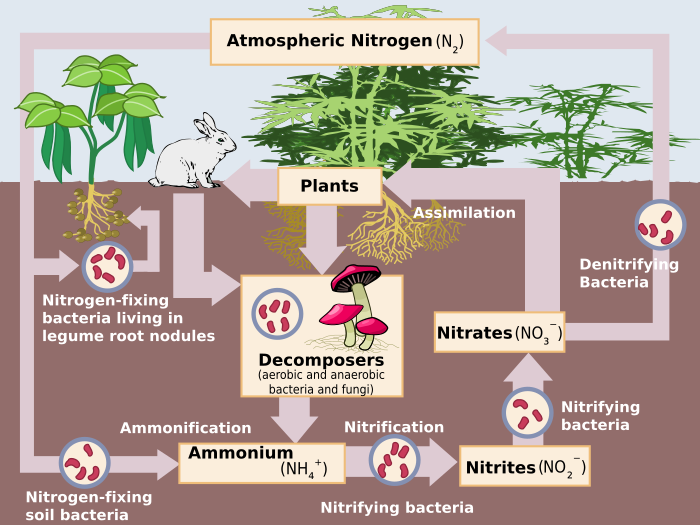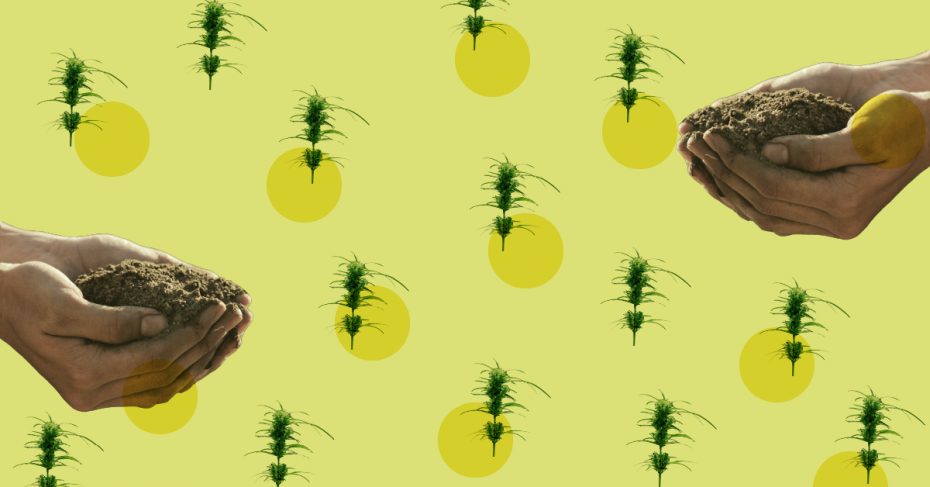Living Soil and the Microbiomes from Human to Plant
In the human gut there is a microbiome where bacteria play a large role in our wellbeing. Plants have a similar microbiome in and around the soil that makes contact with the plant’s roots. This living soil area is called the rhizosphere.
The rhizosphere enables us to grow! The higher the quality of the rhizosphere/soil, the higher the quality of your grow. Strong rhizosphere environments like these create the oppourtunity to grow the highest yielding indoor strains, such as "Blue Dream". After learning about soil quality's impact on cannabis growth, check out our resource to find the highest yielding indoor strain for your grow: What is the Highest Yielding Indoor Strain for Cannabis?. Once you've gotten cannabis strain selection out of the way, sourcing will be your next step. Check out our resource on cannabis strain selection as well.

Influence of the Rhizosphere on Soil
- Changes oxygen concentration
- Effects water absorption and moisture levels
- Chemical effects on ability to gain electrons
The rhizosphere contains bacteria, fungi, and nematodes that can vary in type and abundance based on factors like soil type, root size, plant species, and environmental conditions. The microbial abundance and species present in the rhizosphere can change over time with the growth stages of the plant.
The Rhizosphere Effect
In the rhizosphere effect, the plant’s roots leak compounds called exudates that attract particular microorganisms. The soil microbes drawn to the roots are a food source for nematodes in the soil. The microbes are digested by the nematodes and provide usable nutrients to the plant when they are passed. Plants and microbes can also communicate with each other through chemical and electrical signals. Chemical signals used by bacteria to communicate with each other can even be mimicked by the plant.
Root exudates are products of photosynthesis like sugars, amino acids, organic acids, hormones, and vitamins that leak from root without using metabolic energy. Exudates attract microorganisms that can utilize and thrive off their nutrient composition. The specific composition varies by plant and plant growth phase and helps plants select the microbial associates that will be most beneficial. Exudates also alter soil properties and are used for plant to plant interaction.
Adding organic matter like compost, bat guano, and worm castings has many benefits. Organic matter helps to suppress pathogens, build beneficial bacteria, improve soil texture, and deliver more nutrients to plants.
Soil Microbes Assist in Plant Nutrition
Nitrogen naturally occurs in the atmosphere, but not in a form that plants can use. In order for plants to use nitrogen, it needs to undergo chemical changes to its natural molecular structure. This process of changes, called fixation, can be performed by certain bacteria. In associative or symbiotic nitrogen fixation, such as that occurring in the rhizosphere, the plant’s roots provide nutrients to sustain microorganisms. In turn, the microorganisms convert nitrogen into a form that the plant can use. The alternative way to supply a plant with nitrogen is by use of fertilizers that supply the plant with ready to use nitrogen in the form of ammonia and nitrate.

Rhizobacteria, Endophytes, and Mycorrhizal Fungi
Endophytes are microorganisms living inside the plant tissue. Like the rhizobacteria, endophytes have a beneficial association with the plant. They can coevolve with host plant and grant it survival benefits like better resistance to pathogens. Some endophyte species show effective antimicrobial activity against pathogenic bacteria include Escherichia coli, Staphylococcus aureus, and fungal species Candida albicans. Gray mold, damping off, and pink rot disease are major pathogen threats to Cannabis sativa. The endophyte fungi Paecilomyces lilacimus and Penicillium copticola can inhibit both pathogens and have been found in naturally resistant cannabis plants. 'Tissue Culture Propagation' is an uncommon yet highly scalable innovation in the growing space.
Mycorrhizae are sometimes confused with endophytes. They are a fungi that associate with a plant’s roots. Unlike symbiotic endophytes, mycorrhizal associations are not always beneficial and can turn parasitic.
Rhizobacteria are bacteria that are abundant on the surface of plant roots. These bacteria can stimulate plant growth in addition to mitigating environmental stress and suppressing harmful bacteria by increasing disease resistance in the plant. Rhizobacteria tend to be specific to particular plants and are the source of “local flavor” found in products like wine. The rhizosphere selectively promotes and attracts beneficial bacteria like Pseudomonas species which are very effective in suppressing disease in soil.
Mycorrhizae are sometimes confused with endophytes. They are a fungi that associate with a plant’s roots. Unlike symbiotic endophytes, mycorrhizal associations are not always beneficial and can turn parasitic. When they are compatible with a plant some species can act like root-extensions and help the plant gather water, oxygen, and nutrients.
What Endophytes and Rhizobacteria Do for Plants
- Produce chemical precursors to plant compounds that the plant is unable to produce on its own
- Growth hormone indole-3-acetic acid (IAA) production increase due to increased production of precursor substance tryptophan
- Increased root length (due to increased IAA)
- Processing of phosphate and nitrogen to make them available to plant
- Break down metals into micronutrients that nourish the plant
- Aid in plant cell degradation by using dead plant cells as a nutrient source
- Improve stress tolerance to soil salinity
Glomus for Cannabis?
Mycorrhizae can be problematic when they are too abundant or when they pair with a plant that isn't a good host. Some plants do not have the traits to supply nutrient resources to itself and the mycorrhizae. In the case of cannabis, there is evidence that the relationship between the mycorrhizae species Glomus mosseae may be misunderstood. Many popular websites claim growers can boost yields by supplementing soil with mycorrhizae, especially Glomus species. This claim may be based on a brief scientific observation that Glomus mosseae was found associating with Cannabis sativa in an isolated plant sample. Glomus often has very beneficial associations, so it would make sense to extrapolate that it was a beneficial association.
A 2005 study found that Glomus mosseae was detrimental to cannabis. More research in 2012 elaborated that there are several fungal species with beneficial symbiotic relationships with cannabis, however, these species were all endophytes not mycorrhizae. Mycorrhizae have a generally positive effect on soil health, but they could potentially draw heavy metals into cannabis plants and deplete their nutrients away from bud growth.
Mycorrhizae have a generally positive effect on soil health, but they could potentially draw heavy metals into cannabis plants and deplete their nutrients away from bud growth.
Organic Fertilizer Supports Beneficial Microbes
Cannabis cultivators should take care when purchasing probiotic-like plant and soil supplements. A reputable brand will focus on rhizobacteria and endophyte strains that have been shown to be effective. Beyond probiotics for soil, soil quality is key to establishing good microbiomes in the rhizosphere. Most high quality growth mediums will already contain a lot of beneficial microbes.
One great natural fertilizer for cannabis is compost tea. The outcome is a powerful liquid packed with nutrients and beneficial bacteria that will help cannabis plants thrive.
Soil surrounding the rhizosphere effects microorganism diversity inside the plant and in the rhizosphere. One way to boost your living soil's beneficial microorganisms is by using natural and organic fertilizers and soil conditioners. Organic soil amendments don't have to be expensive. Cannabis naturally thrives in manure and compost because of their very high nitrogen content and microbial activity. Soil conditioners and organic fertilizers are a rich food source for beneficial bacteria and fungi and encourage them to thrive.
Adding organic matter like compost, bat guano, and worm castings has many benefits. Organic matter helps to suppress pathogens, build beneficial bacteria, improve soil texture, and deliver more nutrients to plants. One great natural fertilizer for cannabis is compost tea. Compost tea is made by soaking compost and other organic matter like worm castings and fish meal in an aerated bucket for 24-36 hours. The outcome is a powerful liquid packed with nutrients and beneficial bacteria that will help cannabis plants thrive.
Living soil is beneficial to cannabis health. Though its efficacy is impacted by the growing cycle of your facility. Beware of overpriced soil additives, and unproven claims around mycorrhizae. For more information, and actionable tips from our Master Grower on how to improve your yields, please visit our Seed for Success program.
"In a short growing cycle living soil is not really effective. On a longer crop cycle it can work as like any other organic fertilizer, as it takes some time for the decomposition of the enzyme to work."Shlomo Booklin, Master Grower
References
About GrowerIQ
GrowerIQ is changing the way producers use software - transforming a regulatory requirement into a robust platform to learn, analyze, and improve performance.
To find out more about GrowerIQ and how we can help, fill out the form to the right, start a chat, or contact us.

